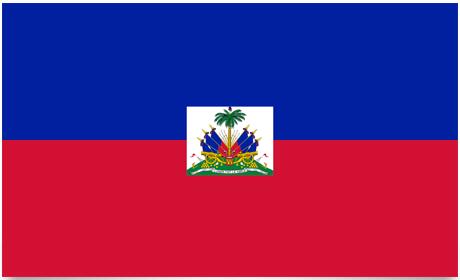Haiti Flag and Meaning
Flag of Haiti

Haiti Flag Meaning
The flag of Haiti is originally based on the French tricolor but was adopted in its current form on February 25, 1986. The blue and red fields were for a long time vertical, just like the tricolor, but were changed to horizontal after dictator Jean-Claude Duvalier had left the country. Blue symbolizes Haiti’s black people and red symbolizes the mulattoes of the country. Black has also been a substitute for blue under the Duvalier regime between 1964 and 1986.
In the middle of the flag is the country’s coat of arms. It is said that the white in the flag had been torn out by the rebel leader Jean-Jacques Dessalines and thus created the flag. It is said that the white in the flag symbolized the whites and that they thereby started the extermination of the whites and in view of the persecutors it could very well be true.
Haiti was also the first country in the world to be independent with a black population and government.
Haiti Overview
| Population | 8.1 million |
| Currency | Gourdes |
| Area | 27.750 km² |
| Capital city | Port-au-Prince |
| Population density | 291.8 residents/km² |
| HDI location | 145 |
Haiti is located on the western part of the island of Hispaniola, the second largest island in the Caribbean. Two mountain ranges intersect the island in the east-west direction respectively. the northern and southern peninsula. The central part of the country consists of highlighters and mountains. To the west, the low lying areas extend to the sea. They are protected by the mountain ranges of the north and east. The country’s most important export product is coffee. In 1976 the extraction of copper ceased and the deposits of bauxite are next depleted. It is the southern coastal area that receives the most rainfall and is the country’s most developed, but it is also this area that is most exposed to erosion. Today, less than 2% of the land is covered by forest.
The People: Most Haitians – almost 95% – are descended from Africans. The rest are mulattoes and there is a small minority of Europeans and Asians. Thousands of Haitians have left their country in recent years and emigrated to Colombia, Venezuela and the United States.
Religion: Voodoo – a mix of Christianity and African religions. Catholicism.
Language: French (official), spoken by less than 20% of the population. The majority speak Creole, which is a language with African, Spanish, English and classical French elements.
Political parties: Front of Hope (Fwon Lespwa/Front de l’Espoir); Association of National Progressive Democrats (Rassemblement des Démocrats Nationaux Progressistes); Respect (respect); The National Christian Union for Reconstruction (Union National Chrétienne pour la Reconstruction d’Haiti); The Christian Movement for a New Haiti (Mouvement Chrétien pour Batir une Nouvelle Haiti).
Social organizations: Catholic Christian base units; The Movement for the Creole Language; The Haitian Women’s Solidarity Organization (SOFA) with 5,000 members is the country’s most important women’s organization; Association of Haitian Workers; Federation of Haiti Trade Unions; The Movement for Assistance to Victims of Violence (MAP VIV); The Platform for Human Rights Organizations in Haiti (POHDH).
Official name: Repiblik Dayti (Creole), République d’Haïti (French).
Administrative division: 9 departments
Capital: Port-au-Prince, 1,728,100 residents (2003).
Other important cities: Carrefour 356,400 residents; Delmas 301,200 residents; Cap Haitien, 119.40 residents; Gonaives, 50,000 residents; (2000)
Government: Jovenel Moïse, President since February 2017. Jack Guy Lafontant has been Prime Minister since March 2017. The House has two chambers: the 83-seat House of Representatives and the 27-member Senate.
National Day: January 1 (Independence, 1804)
Armed Forces: 1,500













































